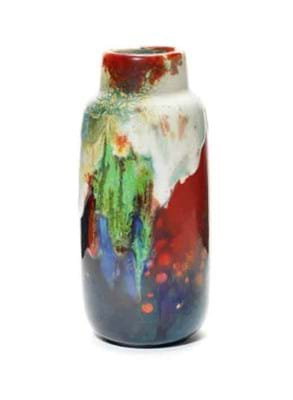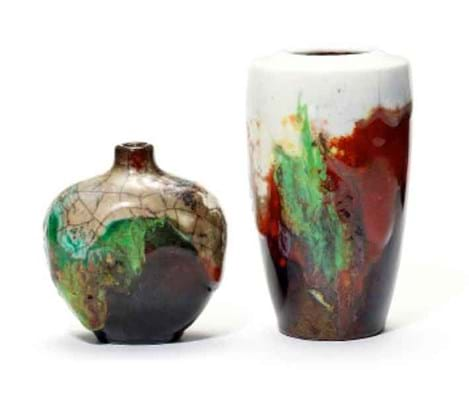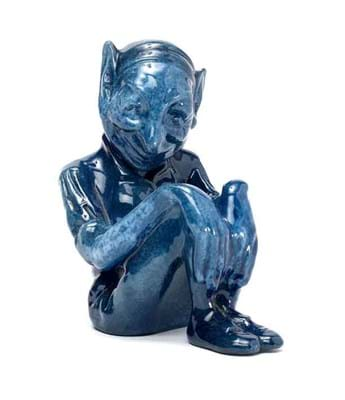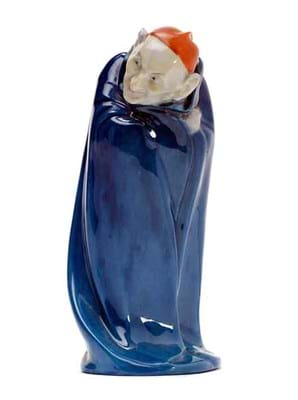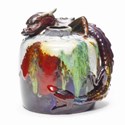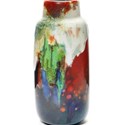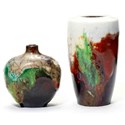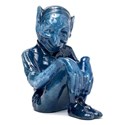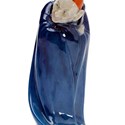Demand for the Burslem figures that 20 years ago used to command entire auctions has fallen dramatically and only the prototypes and rare colourways are on the up now. Likewise, while George Tinworth's quirky rodents or Hannah Barlow's scarcer animal subjects still have a determined collector base, more standard Lambeth stonewares and faience are harder to shift and need careful estimating.
This being the case, Bonhams had clearly got the balance right for their 140 lot offering that formed a large part of the Ceramic Design sale held in their New Bond Street rooms on March 16.
Certainly when one looks at the Doulton high flyers, they fell into the fashionable category of inter-War pieces with experimental glazes. In the auctioneers' Ceramic Design sales last year there was a noticeable preference for unusual or experimental glaze variations, and especially anything lustred or flambéd.
That trend continues. Perhaps the best example this time around was provided by the catalogue cover lot, a mid 1920s vase by Charles Noke and Harry Nixon decorated with experimental Chang glazes and modelled with a dragon coiled sinuously around the body. It carried a £10,000-12,000 estimate, but in its favour, felt Mark Oliver, was its pristine condition without the usual wear to the scales or the tips of the horns seen on other examples he has encountered.
Nonetheless, it came in just under estimate at £9800, a reflection of the fact that this was a lot on which VAT was additionally payable on the hammer price.
The sale also included a whole series of non-sculptural wares by the same duo covered in similar characteristic thick colourful dripping Chang glazes. Varying in size from 3 to 11½in (8 to 29cm) high, these ranged in price from £750 up to £5500.
There were also some more standard Doulton figures whose attraction lay in the variant of an experimental glaze like a hitherto unrecorded version of HN51 (Spook) covered in a Titanian glaze that realised £3600, or a Titanian-glazed version of HN380, a seated gnome. This went for £5000, which was £500 more than was paid for another Titanian-glazed version in the equivalent sale last year.
A Sung vase with a lion and lioness signed by Arthur Eaton and Noke was impressive at 12½in (32cm) high but was held back by some surface scratches which kept the price just under the low end of a £6000-8000 estimate at £5200.
The Lambeth wares were thin on great Hannah Barlow animal subjects and quirky pieces of Tinworth's anthropomorphism this time, leaving as the best seller a large plaque conventionally but very finely painted by Florence Barlow with a study of a large macaw and three manakin birds perched on a branch. This swept past its £3500-4000 guide to take £6500.
Moorcroft
Much of Bonhams' sale last autumn was given over to the mammoth Richard Wright collection of Moorcroft, a 290-lot ensemble that contributed £290,000 to that sale's overall coffers. This March offering wasn't quite in the same league in terms of size or value, containing two smaller single-owner properties and a smattering of mixed-owner wares, but the selling rate was just as high as for the Wright ensemble with all bar 18 of the 135 lots changing hands.
Nothing quite reached the height of the £16,000 paid in the Wright sale for the rare Moorcroft advertising plaque, but there were substantial prices paid for rare or desirable patterns, unusual glazes or colourways, most of which came from a small, 18-lot collection consigned from New Zealand.
This included a rare 6in (15.5cm) high example of a landscape vase with a brilliant flambé glaze that went for £6500; an early and very unusual landscape vase decorated with a pattern of poplar trees pictured in ATG No 1980 that despite restoration outstripped its £800-1200 guide to take £5500, and a Moorcroft octagonal clock case in the Eventide pattern, also previewed, at £4000.
Topping all these at a within- estimate £9800 was an 8in (20cm) high, two-handled squat vase from another source painted with the Waratah pattern. This design, made for the Australian market, is one of Moorcroft's more desirable patterns, but what picked this version out was its flambé variant glaze and good condition.
The buyer's premium was 20/12%.


